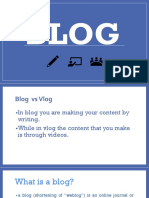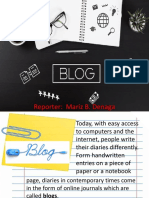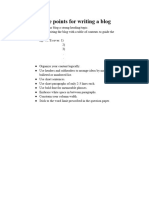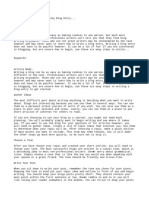0% found this document useful (0 votes)
1K views1 pageBlog Writing - Format
The document outlines a format for blog writing, emphasizing the importance of a catchy title and a clear byline. It details the structure of the blog, including an engaging introduction, a body that elaborates on the topic with a conversational tone, and a conclusion that summarizes the main message. The guidelines encourage the use of simple language and logical organization throughout the blog.
Uploaded by
purnima.singhCopyright
© © All Rights Reserved
We take content rights seriously. If you suspect this is your content, claim it here.
Available Formats
Download as PDF, TXT or read online on Scribd
0% found this document useful (0 votes)
1K views1 pageBlog Writing - Format
The document outlines a format for blog writing, emphasizing the importance of a catchy title and a clear byline. It details the structure of the blog, including an engaging introduction, a body that elaborates on the topic with a conversational tone, and a conclusion that summarizes the main message. The guidelines encourage the use of simple language and logical organization throughout the blog.
Uploaded by
purnima.singhCopyright
© © All Rights Reserved
We take content rights seriously. If you suspect this is your content, claim it here.
Available Formats
Download as PDF, TXT or read online on Scribd
/ 1












































































